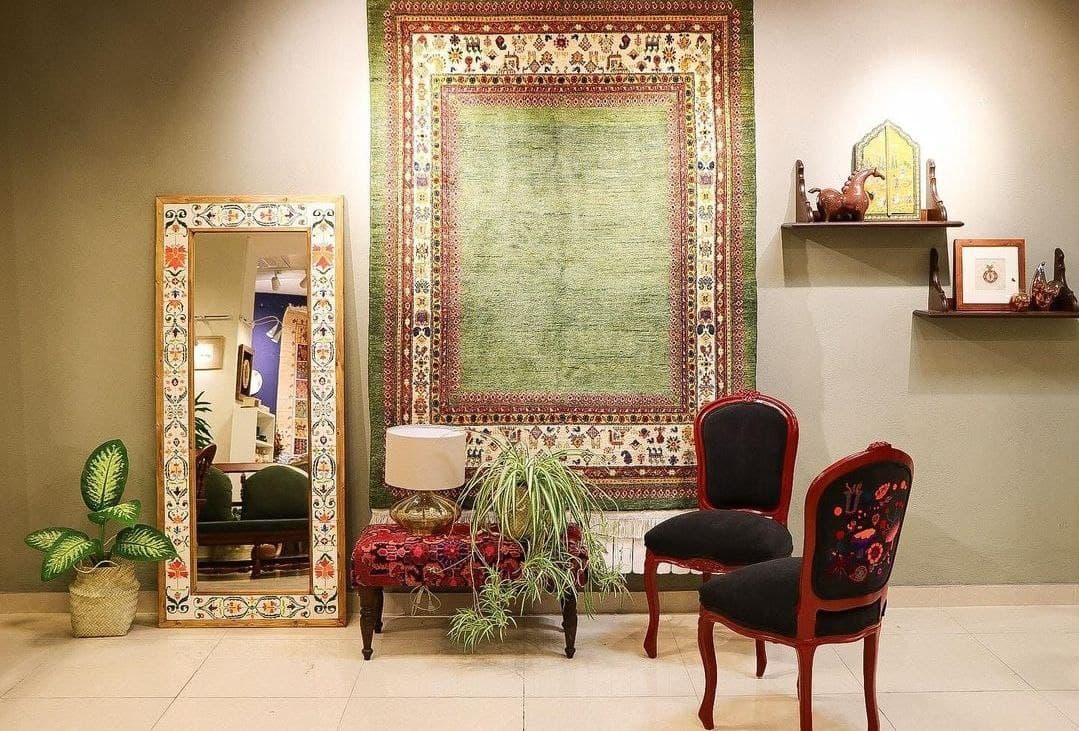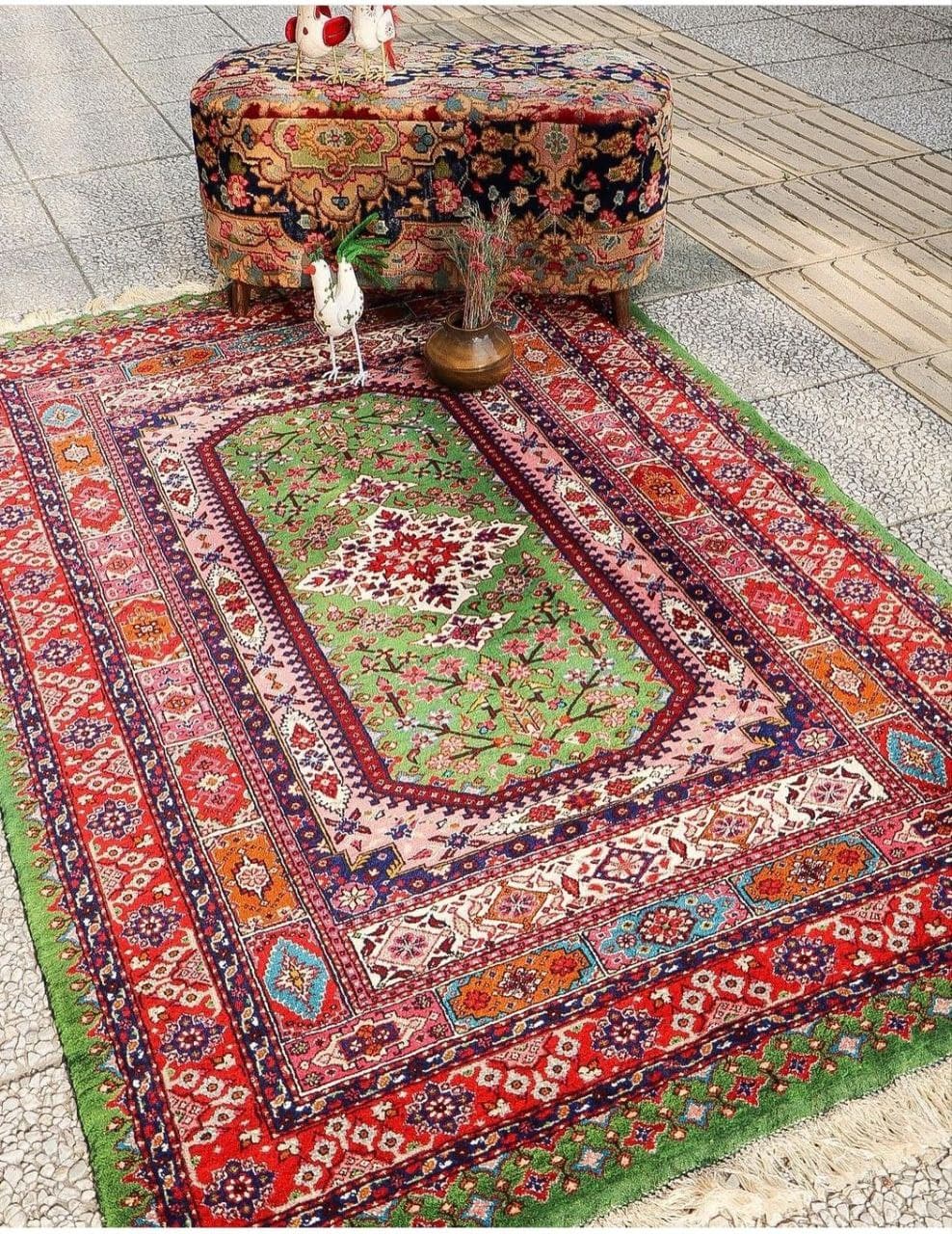Carpet weaving methods
Carpet weaving is a traditional craft that involves creating intricate designs and patterns by hand-tying knots onto a foundation of warp threads. Different cultures and regions have developed their own weaving methods, resulting in a variety of techniques and styles. Here are some of the common carpet weaving methods: Iranian silk carpet weaving involves a meticulous and intricate process carpet designs weaving methods Iranian handicrafts

- Hand-Knotting (Hand-Woven):
- Hand-knotting is the most labor-intensive and time-consuming method of silk rug weaving.
- It involves individually tying knots of yarn around pairs of warp threads to create the pile (the raised surface of the carpet).
- The density of knots, the type of knot used (e.g., Persian, Turkish), and the quality of materials all contribute to the carpet\’s quality.
- Hand-knotted carpets are highly regarded for their durability and intricate designs.
- Hand-Tufting:
- Hand-tufting is a faster method than hand-knotting, but it still involves handwork.
- A tufting gun or needle is used to punch yarn through a stretched fabric backing, creating loops that form the pile.
- Hand-tufted carpets can be made more quickly than hand-knotted ones, making them more affordable, but they are generally less durable. Iranian silk carpet weaving involves a meticulous and intricate process silk carpet weaving methods Iranian handicrafts
- Hand-Weaving (Flat Weave):
- Hand-weaving is a technique used to create flat-woven carpets, which do not have a pile.
- Instead of knots, weavers interlace weft threads with warp threads to create the design.
- Kilims and dhurries are examples of flat-woven carpets created using hand-weaving techniques.
- These carpets are reversible and often used as decorative wall hangings or floor coverings.
- Machine-Weaving (Power Loom):
- Machine weaving involves the use of power looms to weave carpets quickly and efficiently.
- Machine-woven carpets are generally less expensive than hand-woven ones and are produced in a wide range of styles and sizes.
- While machine-woven carpets lack the individual craftsmanship of hand-woven ones, they are more accessible to a broader market.
- Hooking:
- Hooking is a technique used to create carpets by pulling loops of yarn or fabric through a woven base material, such as burlap.
- These loops create the pile of the carpet. Iranian silk carpet weaving involves a meticulous and intricate process pictorial carpet weaving methods Iranian handicrafts
- Hooked rugs are often associated with folk art and have a distinctive, textured appearance.
- Needlepoint:
- Needlepoint is a form of canvas work in which stitches are sewn through a canvas or fabric backing to create a design.
- Needlepoint carpets often have a flat surface with intricate patterns and are commonly used as decorative pieces.
- Latch Hooking:
- Latch hooking is a technique similar to hooking but uses a latch hook tool to create knotted loops.
- It is often used to make rugs and wall hangings with shaggy textures.
- Rag Rug Weaving:
- Rag rug weaving involves repurposing old fabric scraps or rags to create woven rugs.
- Strips of fabric are woven together to form the rug\’s surface.
- This method is eco-friendly and has a rustic, homemade quality. Iranian silk carpet weaving involves a meticulous and intricate process Carpet weaving methods Iranian handicrafts
Each weaving method produces carpets with unique characteristics in terms of texture, appearance, durability, and price. The choice of weaving method depends on factors such as the desired design, budget, and intended use of the handmade carpet.

Iranian silk carpet weaving methods
Iranian silk carpet weaving involves a meticulous and intricate process, and it is highly regarded for producing some of the world\’s most luxurious and finely detailed silk rugs. Here are the key steps and methods involved in Iranian silk carpet weaving:
Click to buy a silk carpet combining machine and handwork machine rugs.
- Design and Cartoon: The process begins with the creation of a detailed design or pattern, known as a cartoon. The cartoon serves as a guide for the weavers and specifies the placement of each knot and the color schemes. Iranian silk carpet weaving involves a meticulous and intricate process Carpet weaving methods Iranian handicrafts
- Materials:
- Silk: Iranian silk carpets are made primarily from silk fibers. The silk used is often of high quality, resulting in a lustrous and soft pile. Handicrafts
- Warp and Weft Threads: Silk carpets have a foundation of warp and weft threads. These threads are often made of silk or cotton.
- Knotting:
- Persian carpets, including silk carpets, are typically woven using one of two knotting techniques: the Persian knot (Senneh knot) or the Turkish knot (Ghiordes knot).
- Weavers tie individual knots of silk yarn around pairs of warp threads to create the pile. The density of knots per square inch contributes to the carpet\’s quality and intricacy.
- Dyeing:
- Silk yarn is dyed to achieve the desired colors for the carpet. Natural dyes are often used, derived from plants, insects, and minerals, to produce vibrant and long-lasting hues.
- Weaving:
- Weaving begins at the lower end of the loom and progresses row by row. The weaver follows the cartoon\’s design, knotting each pile tuft individually.
- The weaver uses a specialized tool, such as a comb or knife, to press down and secure the rows of knots.
- Trimming and Shearing:
- After weaving each row, the pile is trimmed and sheared to an even length. This step enhances the carpet\’s texture and appearance. Iranian silk carpet weaving involves a meticulous and intricate process Carpet weaving methods Iranian handicrafts
- Washing and Finishing:
- Once the weaving is complete, the carpet undergoes a thorough washing process to remove excess dyes, impurities, and any finishing agents. Saffron
- After washing, the carpet is stretched and dried in the sun to set the colors and ensure a smooth surface.
- Fringes and Edging:
- The fringes at both ends of the carpet are finished by knotting or braiding techniques.
- The edges of the carpet may also be secured with a border design.
- Final Inspection:
- A final inspection is conducted to ensure that the carpet meets quality standards. Any necessary touch-ups are made.
- Packaging and Export:
- Once the carpet passes inspection, it is carefully rolled and packaged for export to markets around the world.

Iranian silk carpet weaving is an art form that requires exceptional skill, patience, and attention to detail. These carpets are known for their exquisite designs, fine materials, and intricate knotting techniques, making them highly valued and sought after by collectors and enthusiasts worldwide. Iranian silk carpet weaving involves a meticulous and intricate process Carpet weaving methods Iranian handicrafts
